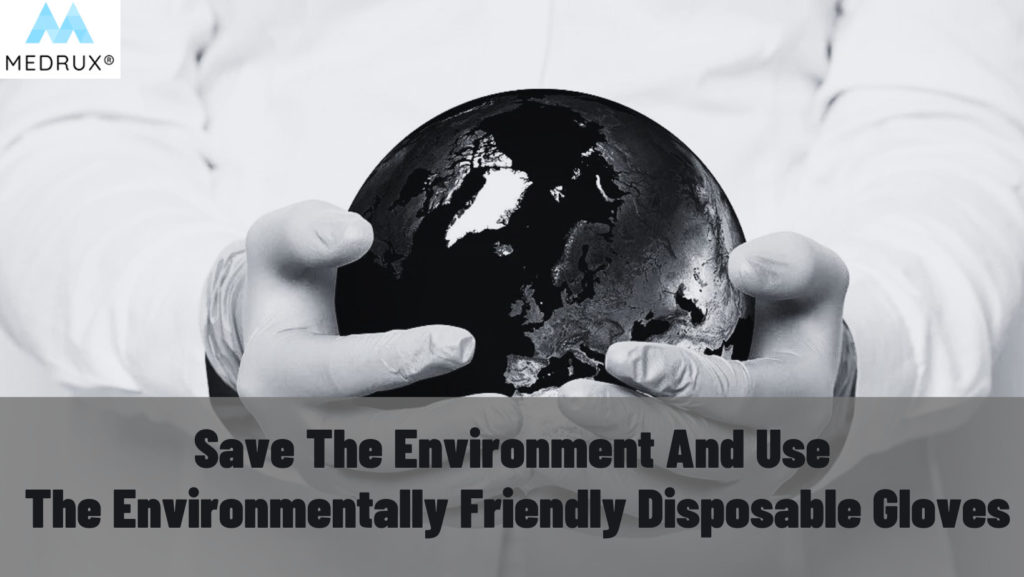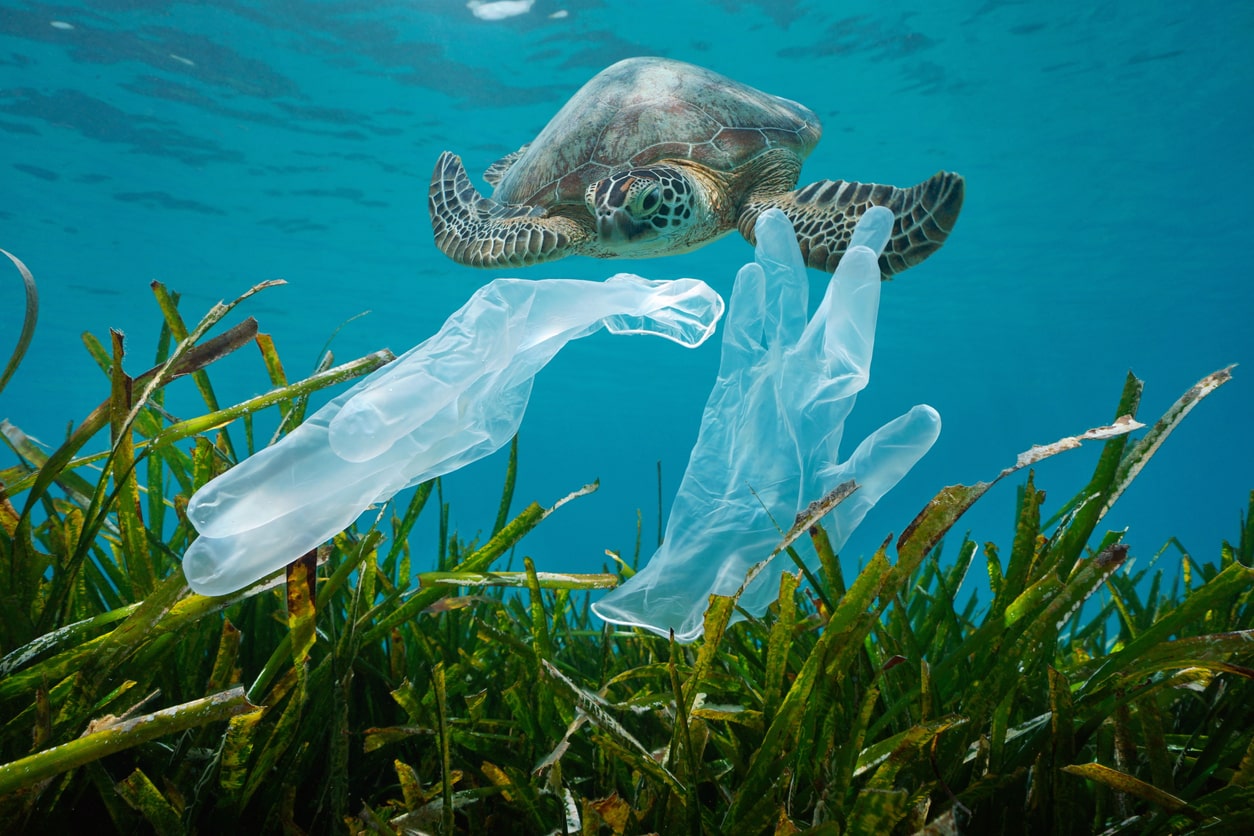Environmentally friendly disposable gloves are now the new trend in our world.
It was all obvious to everyone that when COVID-19 broke out and people sat at home, nature was all breathing well again for the first time in centuries, perhaps.
The pollution rates were down, and even the ozone layer, exhausted for decades, began to heal itself again.
People realized the damage they did to the environment and started going green even harder than ever.
Starting from paper cups and paper straws at coffee shops and paper bags for groceries to environmentally friendly disposable gloves.
People always wear gloves when working in the medical field, food industry, auto mechanics, construction, gardening, car washing, dishwashing, etc.
Disposable gloves are an essential part of our lives now.
They protect us against many hazards, like chemicals, dirt, grime, microorganisms, etc.
They keep our hands shielded against cuts, tears, and punctures.
However, they present a real danger and a serious source of environmental pollution.
That’s why it’s essential to understand more about environmentally friendly disposable gloves.
Nowadays, it should be essential to protect our planet as much as we protect ourselves.
In this article, we will go through the following:
- What does “environmentally friendly disposable gloves” mean?
- Why is it essential to switch to environmentally friendly disposable gloves?
- Are latex gloves environmentally friendly disposable gloves?
- Environmentally friendly Nitrile disposable gloves.
- Biodegradable, Environmentally friendly disposable gloves.
- Environmentally friendly Compostable plant-based PLA disposable gloves.
- The testing of environmentally friendly disposable gloves
let’s begin.
What does “environmentally friendly disposable gloves” mean?
Environmentally friendly disposable gloves mean these gloves are friends with nature, not harming the environment and causing the least amount of damage possible to mother nature.
Not only in the materials used but also in how they are manufactured, packaged, and distributed with fewer resources and less hazardous techniques.
In addition, what happens to these gloves after they are used?
It’s also called “eco-friendly” or “earth-friendly.”
Now glove companies worldwide are working hard to introduce a wide range of environmentally friendly disposable gloves for various applications and industries.
They are offering new biodegradable gloves that decompose naturally faster instead of taking decades to break down.
However, before we go on, we must clarify some terminologies.
Biodegradable means that the gloves decompose or break down naturally by microorganisms such as bacteria or fungi into more straightforward materials such as carbon dioxide, water, or ammonia before they are back into the environment.
Compostable means that the gloves decompose or break down through a human-driven process under specific circumstances into non-toxic, natural elements.
Recyclable gloves can be turned into new products after being used through a different process, resulting in fewer resources and less waste in landfills.
With that in mind, let’s see how vital it is that you switch to environmentally friendly disposable gloves.
Why is it essential to switch to environmentally friendly disposable gloves?
We use disposable gloves daily. They’re convenient, cheap, and do the work, but we throw them away often.
An estimated 150 billion pairs of gloves are produced annually, and an estimated 100 billion pairs of gloves are thrown away yearly.
Moreover, A study in 2020 found a monthly estimated use of 65 billion gloves globally during the time of the pandemic, resulting in widespread environmental contamination (1)
Disposable gloves are made from petroleum-based plastics such as nitrile, vinyl, and polyethylene that are not biodegradable.
So, using environmentally friendly disposable gloves can undoubtedly be a great option to help the planet.
Why?
Because non-biodegradable non environmentally friendly disposable gloves cannot quickly decompose and remain on earth for thousands of years, this affects the environment badly.
Because the more the gloves and other non-degradable materials stay in landfills. The more they pollute our ecosystems, including the oceans.
What’s more, they can end up being washed out by the rain into the oceans, eaten by marine life or wildlife, and killed.
Moreover, they contribute significantly to the building up of gas emissions, the rising temperature of the planet, and hence, global warming and climate change.
On the other hand, when you use environmentally friendly disposable gloves, you reduce the pressure on the landfills to take millions of tons of used disposable gloves.
Furthermore, they reduce carbon emissions significantly while they are manufactured or composted.
Additionally, because they are made from biodegradable renewable and planet-based sources, they turn into carbon dioxide, water vapor, and organic materials that merely cause damage or harm to the environment.
In short, environmentally friendly disposable gloves are better than regular non-biodegradable ones.
What about natural latex gloves?
They come from a natural source, aren’t they? Are they environmentally friendly disposable gloves or not?
Let’s find out.
Are latex gloves environmentally friendly disposable gloves?
Latex gloves are natural rubber latex derived from the rubber tree (Hevea brasiliensis).
They are the most comfortable gloves with exquisite tactile sensitivity and dexterity.
Additionally, they’re durable, protecting against various hazards such as microorganisms, chemicals, and tears.
If you are not in danger of latex allergy, then latex gloves will give you more than you asked for.
Whether latex gloves are environmentally friendly or not is now a debate among people.
Why?
Some people consider disposable gloves made of natural rubber latex environmentally friendly.
Although they are not fully compostable because of the chemicals added, they are made from renewable natural sources and can biodegrade over time.
Latex is biodegradable, and it takes at least 5 years to biodegrade.
Unlike other glove types, such as black vinyl gloves, which are the environment’s worst enemy from when they are manufactured to when they are disposed of, latex gloves can be called environmentally friendly compared to them.
Latex gloves are also biodegradable; they decompose over time, but the time they take depends on the conditions and the chemicals added to the gloves. It can take up to 100 years to biodegrade fully.
Furthermore, latex gloves are not recyclable because they contain germs, dirt, and unwanted materials.
With that in mind, you would say they’re not environmentally friendly.
In addition, synthetic latex gloves (made from petroleum-based chemicals) or blended latex gloves (made by blending natural rubber latex and synthetic latex) are not environmentally friendly.
And because you can never really know the number of chemicals added to natural latex, you can never tell if they are being washed into the oceans, contaminating our marine life or not; there have to be other options.
That’s where biodegradable, environmentally friendly nitrile disposable gloves hop in.
Environmentally friendly Nitrile disposable gloves
Regular nitrile gloves are made of acrylonitrile-butadiene, which is a synthetic rubber. They are not biodegradable by any means.
They can take anywhere from a couple of decades to a few centuries to degrade fully.
However, new technologies have developed to create nitrile biodegradable gloves.
These gloves are made with a new technology called Eco Best Technology (EBT) that makes them degrade within 1–5 years when exposed to a biologically active environment like a landfill.
This technology makes disposable gloves fully sustainable.
In 2012, the first environmentally friendly biodegradable nitrile gloves were introduced. These gloves perform similarly to regular nitrile gloves.
They are durable, offering excellent protection against various chemicals, oils, and acids.
They can be used in a wide range of industries, like janitorial tasks, the pharmaceutical and chemical industries, food processing, automotive, liquid handling, maintenance, and assembly, as well as agricultural, landscaping, and gardening.
They’re considered hypoallergenic.
Why?
Because they are powder-free and accelerator-free with zero natural rubber latex proteins, and they have a decreased risk of allergies.
Unlike regular nitrile gloves, they will degrade and break down biologically when tossed in landfills.
Their biodegradation is accelerated by around 100% faster than regular nitrile gloves.
Furthermore, when biodegraded, they don’t produce harmful microplastics.
On the contrary, when disposed of in landfills, microorganisms consume and break down EBT materials into three natural compounds—organic soil, methane, and carbon dioxide—that can be used as natural fertilizers.
They can be recycled as well.
You might be asking what other types of environmentally friendly disposable gloves we can rely on.
Keep reading. We are already on it.
Biodegradable, environmentally friendly disposable gloves.
These are plant-based compostable gloves made from modified cornstarch that are quickly grown and sourced sustainably and responsibly.
Cornstarch resin is a non-toxic, cheaper, and safer alternative to latex and other disposable gloves.
They’re durable, stretchy, comfortable, and waterproof.
These environmentally friendly disposable gloves are BPA-free and plastic-free.
Furthermore, they’re 100% compostable; they decompose within 180 days in a compostable environment and within 18–24 months in a landfill without leaving any trace of microplastics.
They are even packaged in recycled and compostable packaging.
In addition, they’re economically friendly and much cheaper than nitrile biodegradable gloves.
They are designed for simple tasks like cleaning, cooking, food prep and handling, arts and crafts, hair dying, and light-duty gardening.
After an extensive search, we have come across another type of planet-based, environmentally friendly disposable glove.
Let’s take a look at it.
Compostable plant-based PLA environmentally friendly gloves.
These gloves are made of an eco-friendly plant-based material called polylactic acid (“PLA”).
PLA is a plastic substrate made from any fermented plant-based sugar, such as cornstarch, cassava, sugar cane, or sugar beet.
However, corn is the primary source of PLA.
It has become a popular alternative to traditional petroleum-based gloves such as polyethylene gloves.
They’re fully commercially compostable and can be recycled with garden and household food waste.
Additionally, they’re supplied in recyclable packaging.
One downside to them is that they must be disposed of in commercial composting facilities to be of environmental benefit, and currently, only a few hundred industrial-grade composting facilities can be found across the US.
Now, you might be wondering how you can be sure that these gloves are environmentally friendly or not.
Well, a few tests are required for the gloves to be called environmentally friendly.
The testing of environmentally friendly disposable gloves
Most manufacturers now go the extra mile to make their gloves environmentally friendly to help reduce the environmental damage disposable gloves cause.
A glove must go through a few quality tests to prove it to be environmentally friendly and biodegradable.
There are two international tests made by the American Society of Testing and Measurements (ASTM) to ensure that the gloves are biodegradable, as the companies claim, and can be called environmentally friendly disposable gloves.
Both these tests measure the glove’s percentage of biodegradation.
-
ASTM D5511.
The first test is ASTM D5511, a short-term test method performed under ideal conditions (in a lab).
The glove material is exposed to several processes in which microorganisms break down biodegradable materials without oxygen.
This test intends to produce a certain percentage of carbon from biodegradable material that can be transformed into gaseous carbon.
Based on this short-term test, they assume that the glove will degrade in the long term.
But since this test is done in optimal conditions and for a short period, they need one more test that could mimic the real-life situation for an extended period.
And that’s where the second test comes in.
-
ASTM D5526
The second is the ASTM D5526 biodegradability test, a more thorough long-term test method.
These test results are like those in a real-life environment and are more effective in proving the biodegradability of the gloves.
It’s done over a 3 to a 6-month window, imitating landfill conditions with accelerated simulated conditions consisting of low heat, high pressure, limited oxygen, no light, and low moisture.
In addition to these two tests, there’s a test required for labeling gloves as compostable in municipal or industrial facilities. It’s called ASTM D6400.
Which is a four-part biodegradation test for evaluating biodegradability through composting
The ASTM D6400 test method is somewhat selective for bacterial-based biodegradation over an extended period. It lasts a minimum of 90 days and can last up to 180 days.
Final thoughts,
Environmentally friendly disposable gloves are the new way to go green and help protect our mother earth.
There are a few options, including nitrile biodegradable gloves made with EBT technology and planet-based disposable gloves.
However, we hope there will be plenty of options we can go through in the future.
Don’t worry; we at Medrux will ensure you have the guide to them all when the time comes.
Make sure you read the label well to know if your gloves are compostable, recyclable, or biodegradable.
And don’t forget, the more eco-friendlier products you use, the more you contribute to a healthier, happier planet and more safe sea turtles.
Hajar Nagdy is a microbiologist and a lecturer. Nagdy holds a Bachelor’s degree in the fields of microbiology and environmental sciences, and she is now a M.Sc. candidate in microbiology. In her free time, she can be found listening to classical music, reading interesting scientific articles, running a charity, or traveling across Europe.







